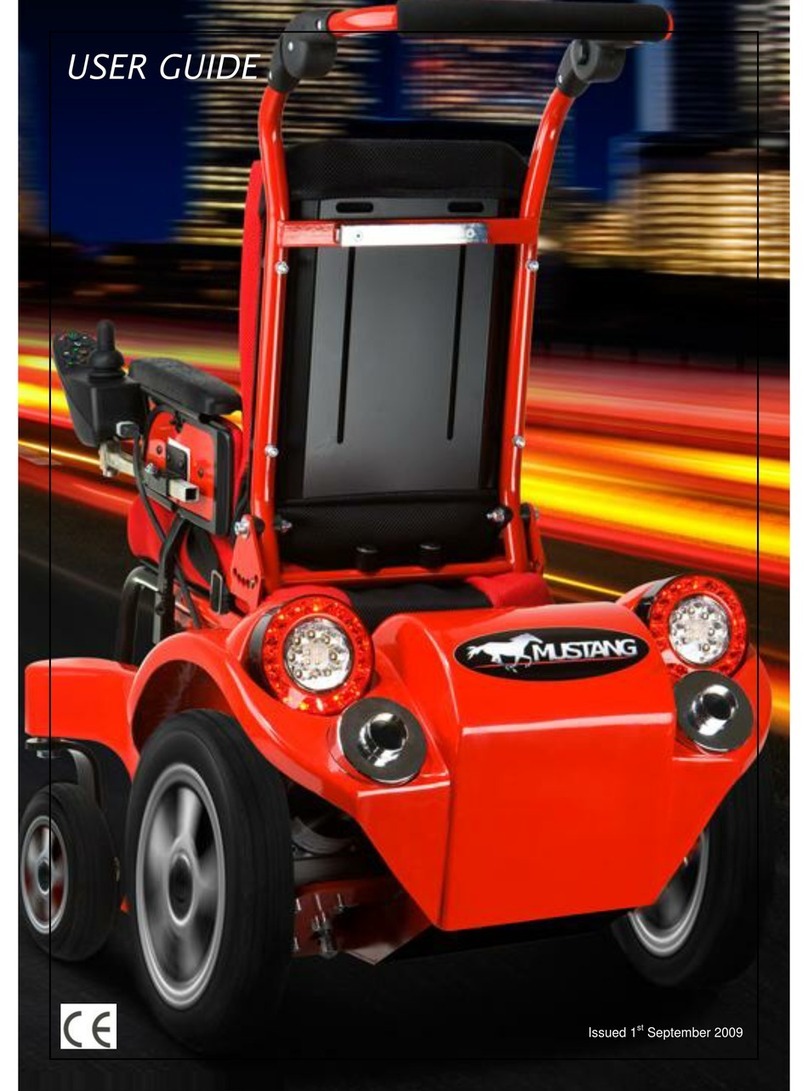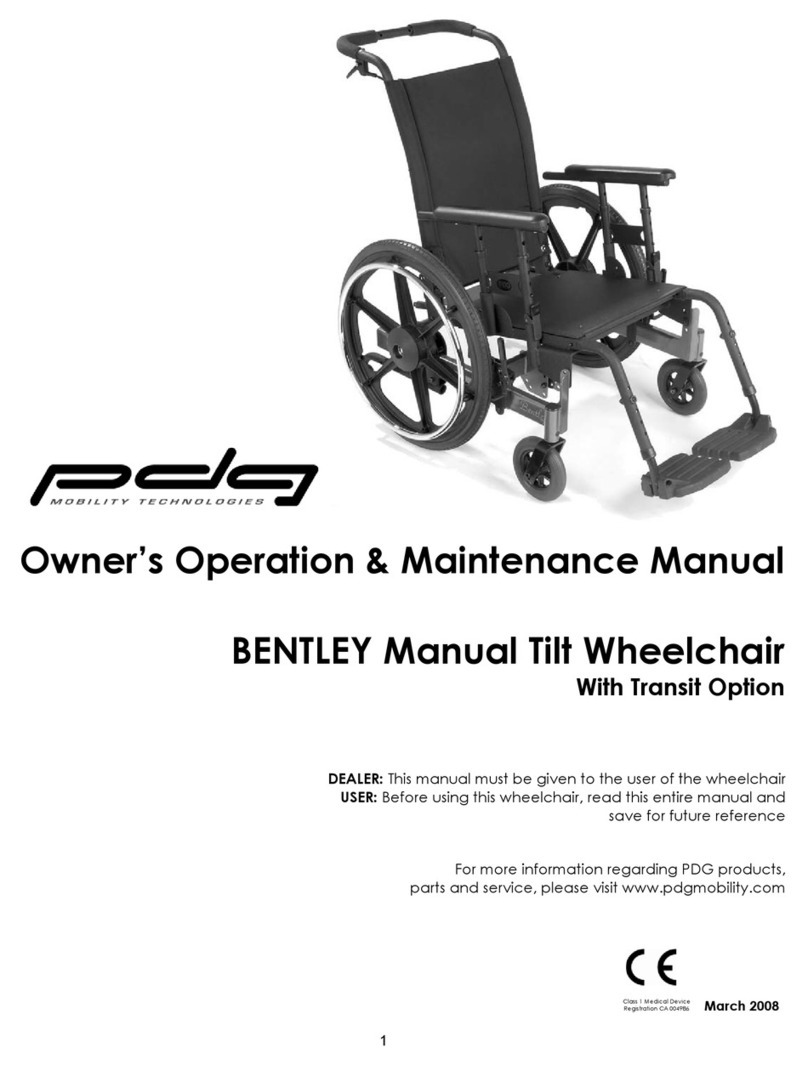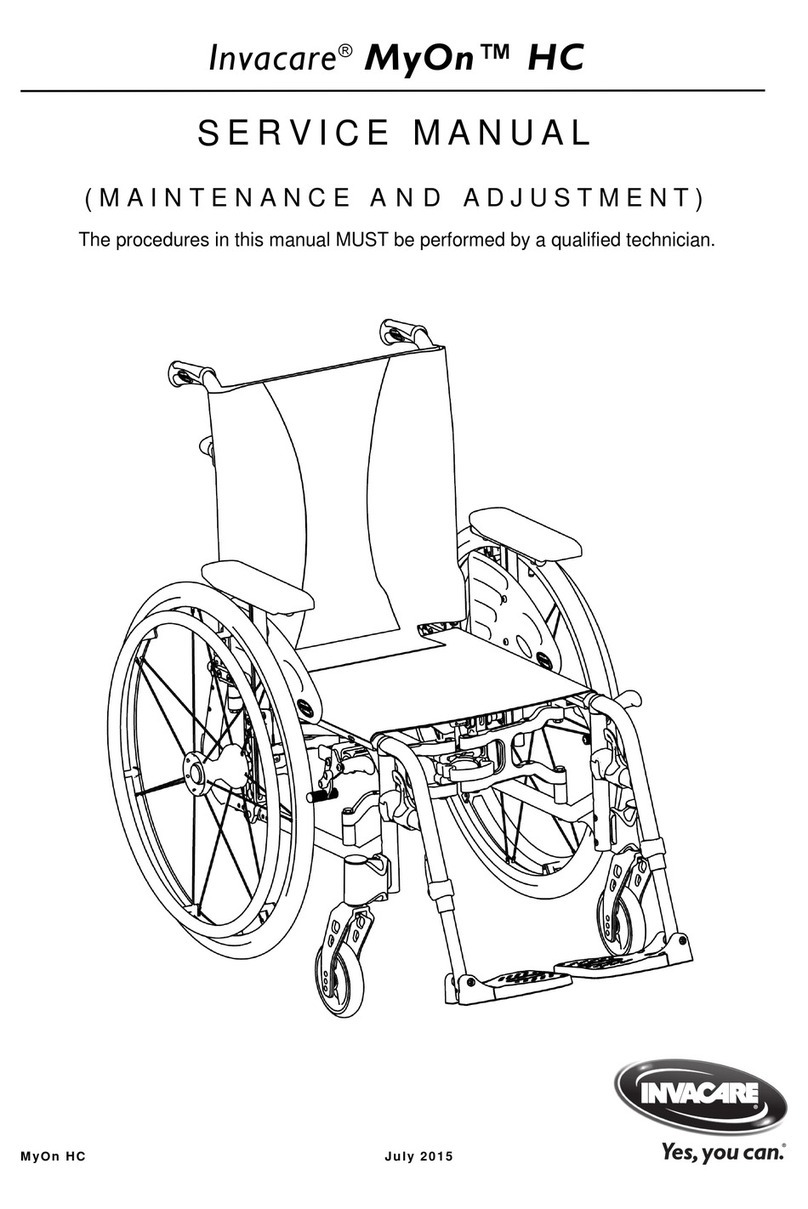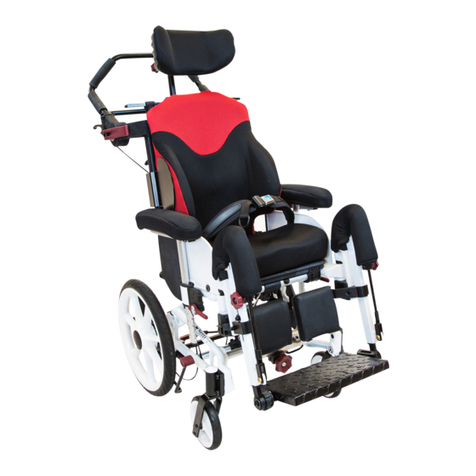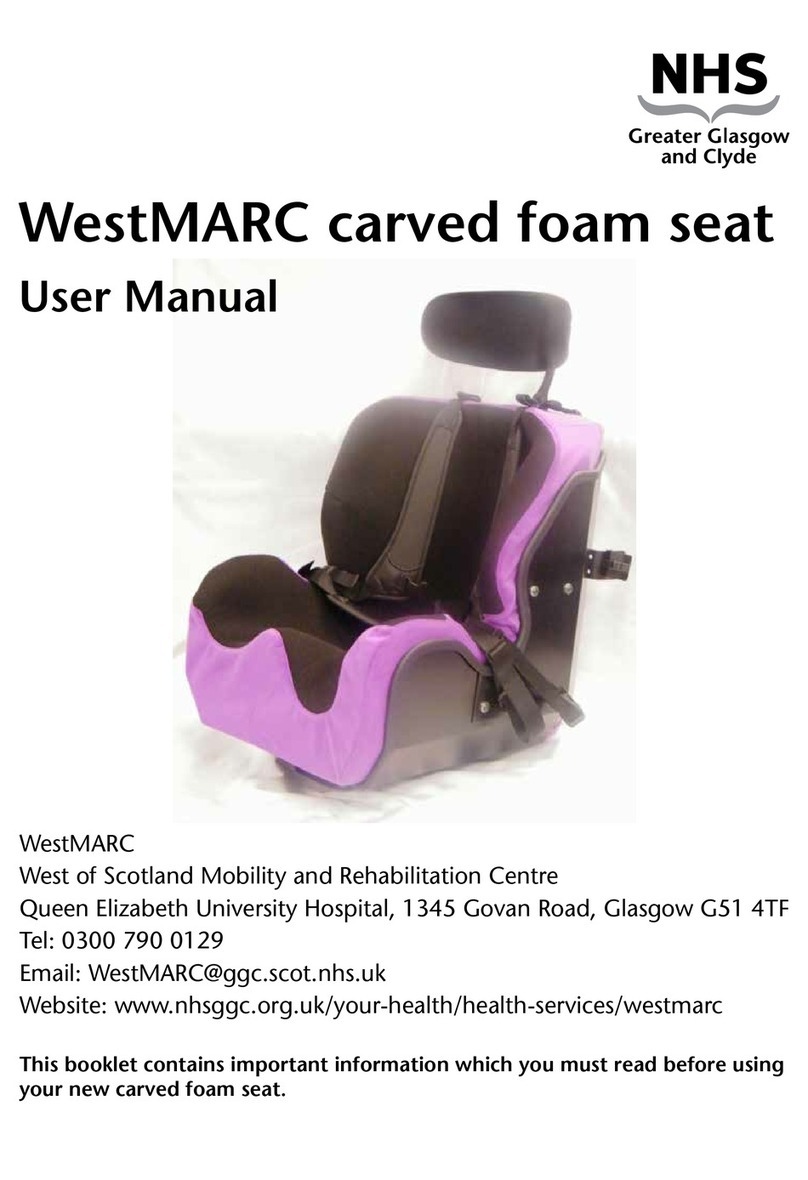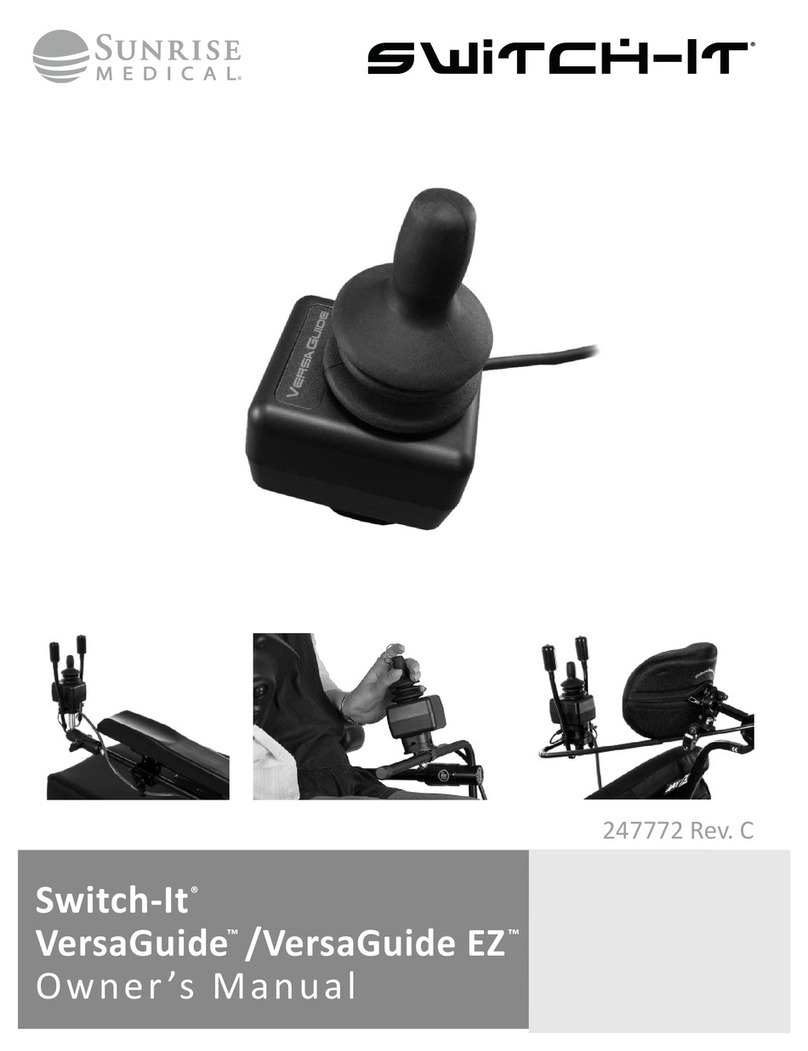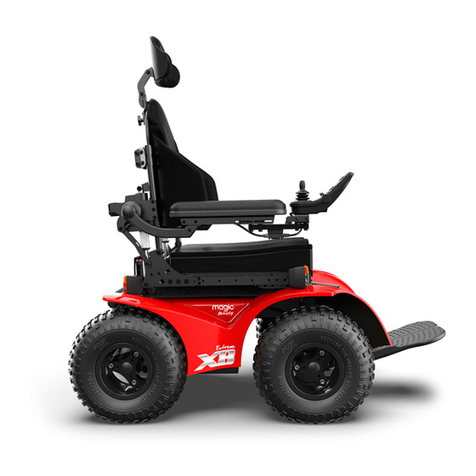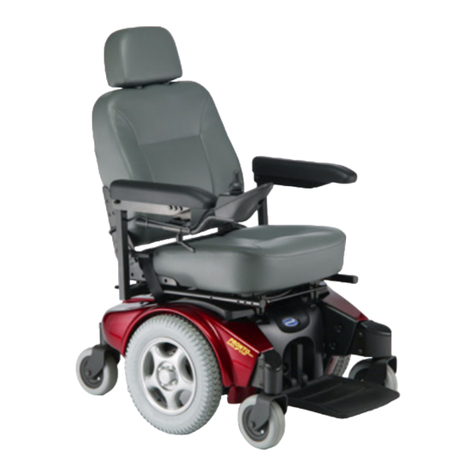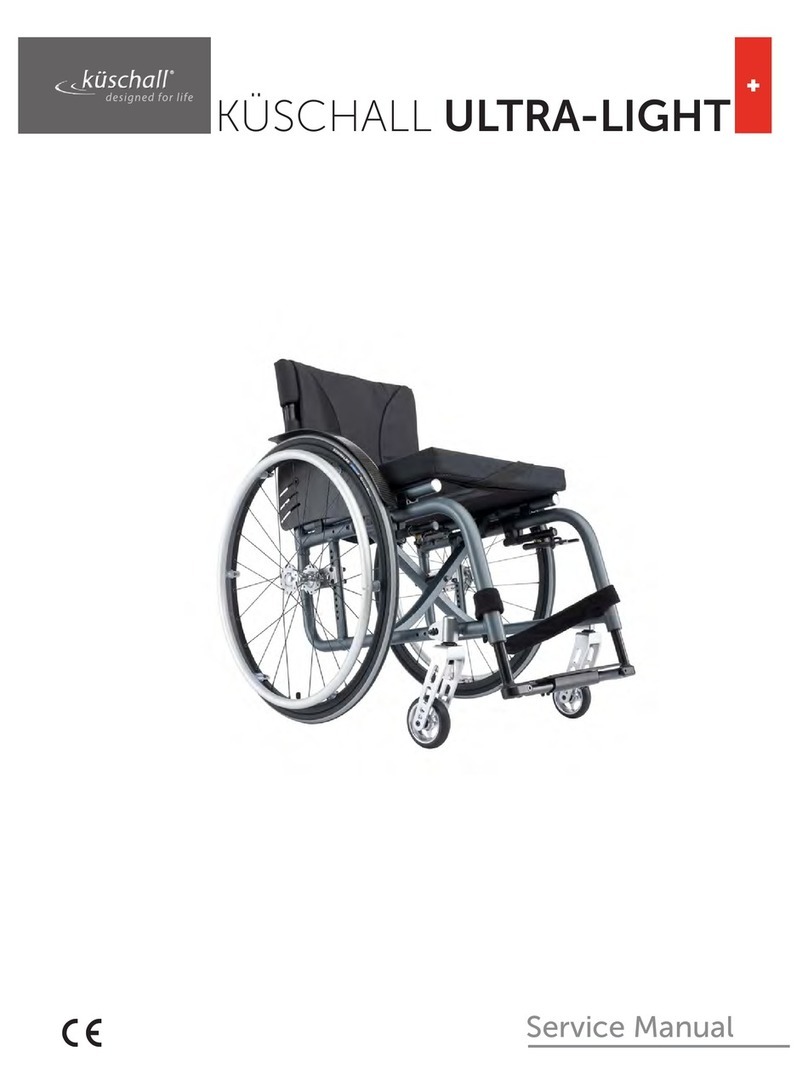Activate Corgi Sprint User manual

USER GUIDE
FOR THE NEW CORGI SPRINT
Issued 27th November 2008


Contents
TITLE Page
Safety Notes 2
Operating Instructions 3 –9
Using your Wheelchair 10
Basic Technical Data 11
Occupied transport in a suitably modified vehicle 12
Details of attachment points 13
Key points relating to transportation 14
Care & Maintenance 15

1
SAFETY NOTES
Please read this user guide fully before using your wheelchair.
Expert medical advice must be sought before using your wheelchair. If you have any doubt about this speak to
your Occupational Therapist.
Before using the wheelchair it is essential to ensure the backrest recline catches are engaged.
Each attendant should be familiar with the operation of the wheelchair. If there is any doubt they should read
this User Guide.
Before setting off, ensure that the occupant is comfortable, and that clothes and any rugs which may be used
are tucked in, so that they do not catch on the wheels.
Always apply the parking brake when the wheelchair is stationary and when getting in and out of the
wheelchair.
Never tip the wheelchair forward when going down a kerb.
If the wheelchair is going to be used for transport in a vehicle you should carefully read the Transport Section
of this guide.
The attendant must take precautions against fire risk. In buildings, check the locations of fire exits and make
sure the emergency procedures are understood.
Do not let children play with, or hang on the wheelchair.
Do not use your wheelchair in a manner for which it is not designed.
Ensure that children are clear of moving parts before making adjustments.
Activate and your dealer cannot accept responsibility for the use of accessories other than those supplied by
them.
Full concentration must be maintained during travel to avoid collisions or other dangerous situations.
Make sure that the wheelchair brakes are applied while adjusting the recline or the tilt of the seat. This will
leave both hands free to operate these features, avoiding sudden movements which will cause discomfort to
the occupant.
Do not overload the wheelchair. Other children should not ride on the back of the wheelchair, nor should loads
be attached to the frame other than on the approved accessories.
Ensure that the occupant has the appropriate harness attached and other accessories fitted and adjusted to
their requirements to prevent them from falling out of the wheelchair while travelling.
Do not stand on the footrest. Ensure the occupant’s feet are settled into the footrest before setting off.
Never leave the child unattended in the wheelchair at any time.
At all times when operating the wheelchair, be aware of the danger of injury to yourself, the occupant, or any
other person, especially when going through narrow areas such as doorways.
Activate and your dealer cannot accept responsibility for any loss, damage or injury as a result of incorrect
operation of your wheelchair.
2

Operating Instructions
FOLDING OF THE CORGI SPRINT
To fold or unfold the Corgi Sprint the seat is removed
The seat is removed by releasing the lever as shown
The Seat unit will then tilt backwards and can be lifted off the seat interface
3

Removing the rear wheels.
The rear wheels are removed by pressing the button in the centre of
the wheel as shown in the picture. When replacing the wheel you
should clip it on and give it a shake to make sure that catch has
engaged
Locking the front castors
The front castors can be fixed so that they are in line with the rear wheels for a straight direction of
travel. The pin is rotated to allow it to slide into the hole in the top of the castor.
4

BACKREST RECLINE ADJUSTMENT
To adjust the back of the seat, the two catches can be
pushed together, towards the centre and the back
reclined into the required position.
Please ensure that the catches are fully engaged
before setting off.
You should also check with your therapist about the
use of the recline function.
The child’s posture may not be acceptable in the
reclined position.
USING THE TILT FACILITY
To use the tilt, the small lever on the right-hand hand side is
used. Press this lever with your foot to release the Tilt Strut
so the chair can then be pushed downwards into the desired
position.
Please ensure brakes are on while using the tilt facility.
The New locking Tilt pedal is is locked by locating the pop –pin as shown in the first picture. If the
tilt lock is not required is can be held open by rotating the head 90 degrees to rest in the open
position.
LATERAL SUPPORT RELEASE
When placing the child into the wheelchair it is advised to swing the lateral
supports away to the sides of the chair. To do this the ball underneath the
attaching block can be pushed up which will release the support to be swung
away.
Ensure that the lateral support is clicked into place while the wheelchair is in use.
LATERAL SUPPORT ADJUSTMENT
To adjust the positioning of the lateral support there are two bolts on the back of the
seat which can be loosened and the support will then slide up and down, to the
preferred position, and moved in to support the trunk of the occupant.
Please ensure the bolts are fully tightened before using the wheelchair.

OPERATING THE BRAKES
When parking the wheelchair, the brakes should be applied. This is done by pushing the brake
lever down to lock it against the wheel as shown.
ADJUSTING THE HEIGHT OF THE HANDLE
To raise or lower the handle at the back of the wheelchair the buttons on the adjustment knuckles
should both be pressed in. The handle can then be moved to the desired position and the buttons
released. The locaters inside the knuckle will click into place automatically to secure the new
position.
ADJUSTING THE ARMREST
To adjust the height of the armrest there is a small hand wheel
which can be unwound to release the grip. The armrest can
then be pulled up or down and re-positioned and the screw
then tightened.
When adjusting the armrest ensure the occupant’s hands are
kept away from the armrest, to prevent catching fingers when
repositioning the armrest.
6

ADJUSTING THE HIP GUIDE
The hip guide can be adjusted for height by releasing the hand
wheel as shown.
INCREASING WIDTH OF HIP GUIDE
To increase or decrease the seat width, the hip guides can be
pulled outwards. This is achieved by using a hand wheel which
grips the main attaching bar of the hip guide to the base of the seat.
This handwheel is found underneath the seat. The hand wheel can be loosened and the hip guide
will then slide out to the preferred position. The hip guides will slide out individually to fit the
occupant. The hand wheel will then need to be tightened in the new position before use.
MOVING THE POMMEL
The pommel can be taken off the seat to assist with putting the
child in the wheelchair. This can be done by loosening the
screw fitting in the centre (on the underneath of the chair) at the
front. When the screw is loosened, the pommel bar will slide
out of the bar attached to the base, and the pommel will come
off the chair. This can be replaced by sliding back into the
holder and the screw tightened.
Ensure the pommel is firmly secured before setting off.
THE DOUBLE FOOTREST
The double footrest is made up of two separate footholders with a back support and a grip base to
ensure the child’s foot is secure. Each foot piece is angle adjustable.
THE SINGLE FOOTREST
The angle of the footrest can be adjusted by using the lever
handle on the bar underneath. When this lever handle is
unwound, the footrest can be tipped back or forward to re-position
it. When the preferred position is obtained the lever handle can
be tightened. To re-position the handle, the centre button can be
pushed in and the handle moved to a different position.
TO LOWER THE FOOTREST
If the footrest is too high or too low for the child this can be
adjusted by loosening the bolt on the end of the bar which is
attached to the chair. Then the bar can be lowered or raised to
suit the child. When re-positioned, the bolt should be tightened
and the footrest is ready to use.
7

TO REPOSITION THE FOOTREST
There is also a facility to reposition the entire footrest away from, or in
towards the wheelchair. This is achieved by using the screw fitting on
the side of the chair at the very front, which holds the bar attaching the
footrest to the base. When this screw is loosened the bar can be pulled
or pushed to a new position, and then the screw should be tightened.
The footplate can be removed when stowing the wheelchair into a
vehicle.
INDIVIDUAL SWINGAWAY AND FLIP-UP FOOTPLATES
The individual swingaway footplates allow access for self loading. The footrest hangers are
removable, or they can be rotated out of the way. The footplates themselves flip up , which may be
sufficient for some situations.
ADJUSTING THE HEIGHT OF THE SWINGAWAY FOOTPLATES.
The footplates are bolted to the vertical tube, which is pre-drilled for height settings. The footplate
bolt should be removed and the the footplates re-mounted in the desired position.
8

HEADREST HEIGHT ADJUSTMENT
The headrest can be lowered or raised by using the screw fitting on the
silver block at the top of the chair back. When loosened the main bar
can be moved and the screw re-tightened.
Ensure the screw is fully tightened before the child uses the headrest.
HEADREST ANGLE ADJUSTMENT
To adjust the positioning of the headrest in relation to the child’s head, there is a small handle
which can be unscrewed and the headrest can be moved up or down on the arm, to suit the child’s
posture.
Ensure that the headrest adjusting handle is fully tightened before use, so the best position is
secured for the occupant.
TO SET THE HEADREST
To move the headrest to the perfect position for the posture of
the child, a spanner is needed to loosen a bolt in order to move
the cushion on a pivot up or down. When the headrest is in the
required tilt, the bolt can then be tightened before use.
TRAY TABLE ACCESSORY
The tray table is fitted into the armrest by a long pin attached to
the underside of the tray, which is inserted into a hole in the end
of the armrest. This will then slide along so the tray is secure
around the child. There is a rubber rim around the edge of the
tray to prevent objects falling off.
9

Using your wheelchair
GETTING INTO THE WHEELCHAIR
Make sure that that the two individual brakes are on. Either ask another helper to steady the
wheelchair or place the handle up against a wall to minimize the risk of tipping. Place the child in
the wheelchair, fasten the harnesses and make sure no clothing or rugs are caught on the
pommel. It is also advised to check that the child’s feet are in a suitable position in the footrest.
GETTING OUT OF THE WHEELCHAIR
Make sure that the brakes are on. Reverse the procedure for getting into the wheelchair.
NEGOTIATING A KERB OR SINGLE STEP
To go down a kerb, approach the kerb until the front wheels are near the edge. Grip the handles
firmly and tip the wheelchair backwards to balance on the rear wheels. Lower the wheelchair
over the kerb on the rear wheels, returning the front wheels to the ground when you have
reached the lower level.
NEVER TIP A WHEELCHAIR FORWARDS AT A KERB
ALWAYS MAKE USE OF RAMPS AND LIFTS IF THEY ARE AVAILABLE
DO NOT ATTEMPT TO MOUNT A FLIGHT OF STAIRS OR STEPS
FOLDING THE WHEELCHAIR
To fold the wheelchair for handling, the seat can be tilted forward so the chair can be made more
compact.
See instructions for tilting the backrest on page 4.
The Corgi Sprint wheelchair is designed to grow with your child. This means that the
wheelchair will be used over a number of years. The seat position and the postural
accessories will need to be checked regularly by your therapist. It is also important
not to adjust the seat without your therapist, as it could have a detrimental effect to
your child’s posture. Correct positioning is crucial to your child’s muscle and bone
structure development.
10

Basic Technical Data
01 02 03
Seat width 260 -320 280-350 330-400
Seat depth 190-360 290-430 300-440
Backrest width 290 340 380
Later support width (inside) 220-320 270-350 310-380
Seat to footplate 300-420 300-420 330-450
Overall width 470 470 530
Handle height 980-1040 980-1040 980-1040
Seat height to floor 520 520 520
Recline range (degrees) 14 14 14
Tilt max. (degrees) 30 30 30
Corgi Power (2 x 200 watt motors, 2 x 24 amp batteries)
Seat height 350-450 350-450 350-450
Dimensions given may be subject to minor change due to continuous development
11

Occupied transport of a Corgi Sprint in a suitably modified vehicle
SECURING THE WHEELCHAIR TO THE TRACK SYSTEM IN THE VEHICLE FLOOR
The Corgi Wheelchair must be secured to the vehicle floor using a 4-point webbing restraint
system. The Hook or Karabiner version should be used.
THE WHEELCHAIR MUST BE IN A FORWARD FACING POSITION.
Wheel the wheelchair into position and apply the brakes. The front of the wheelchair is secured
first. Attach the front restraints to the track system making sure that they are locked in position.
Attach the restraint to the tie-down point which is clearly marked on the wheelchair chassis. Now
that the front of the wheelchair has been secured, carefully move the wheelchair backwards to take
up the slack in the front restraints, and re-apply the brakes. The rear restraints are attached to the
backrest bracket of the wheelchair frame at the clearly marked attachment point. When the
restraint is also attached to the track system in the vehicle floor, use the ratchet to pull the restraint
tight. Make sure that you have tensioned the restraint on both sides of the wheelchair, and check
that the wheelchair feels secure.
The restraints should be attached at an angle of no more than 45 degrees to the vehicle floor. If
you are in any doubt, contact the restraint manufacturer for specific instructions relating to their
system, or your dealer for queries relating to the wheelchair.
SECURING THE PASSENGER RESTRAINT AROUND THE OCCUPANT AND ATTACHING TO
THE TRACK SYSTEM IN THE VEHICLE FLOOR.
The following points relate to the safety of the occupant:
Check that occupant weighs no more than 35kg.
Make sure that the seat base is at 90 degrees to the seat back. The seat back should be as
upright as possible.
No additional seating cushions should be used in transportation.
The wheelchair occupant is protected by a 3-point passenger restraint, described by the restraint
manufacturer as a SPLIT REEL DOUBLE INERTIA.
The double inertia reel is attached to the track system on the track closest to the vehicle wall, on
which the upper torso anchorage is mounted. The stalk with the buckle is placed opposite the
double inertia reel on the other track. These should be positioned about 14 inches/350mm behind
the wheelchair backrest to ensure a steep angle of application of the lap belt. The lap belt is reeled
out from the front of the double inertia reel, fed between the wheelchair hip guide and the backrest
in order to maintain a steep angle over the pelvis. The belt must fit snugly over the pelvis and
between the hip guide and the backrest on the other side of the seat unit. The clip then attaches to
the stalk, which is fixed to the track in the vehicle floor. The lap belt should be adjusted to be close
fitting to avoid abdominal intrusion on impact.
The upper torso restraint is reeled out of the rear of the double inertia unit. The leading clip is
passed over the occupant’s shoulder, and attached to the buckle on the lap belt. This will be found
just above the lap belt attachment to the stalk. The remaining clip is then attached to the restraint
anchorage on the vehicle wall. This should be adjusted to be at, or just above, shoulder level. The
upper torso restraint should be adjusted to be close fitting and comfortable for the occupant.
12

Details of attachment points
The Front Restraints are attached as shown on the
picture on the right
The Rear Restraints are attached to the
bracket as shown below. Or the more recent
models have a tiedown bracket as below.
13

Key points relating to transportation
1. The wheelchair must face forwards in the vehicle –in the direction of travel.
2. The wheelchair must be restrained with a 4-point tie-down. No other restraint system must be
used.
3. The occupant must be restrained by a 3-point passenger restraint.
4. The passenger restraint should be anchored at, or above, shoulder level.
5. The lap section of the passenger restraint should fit snugly over the pelvis of the occupant, at a
steep angle of application to avoid abdominal intrusion.
6. Check with the vehicle converter that the vehicle floor and side wall structures have the
appropriate strength required by the restraint manufacturers for the installation of the restraint
systems.
7. Check that the vehicle converter has fitted the restraint system in conjunction with the restraint
manufacturer. All manufacturer’s recommendations and guidance notes should be followed.
8. Check that all vehicle operators are suitably trained in the use, care and maintenance of the
restraints.
Features to check on the wheelchair after the restraint system is in place
Are the brakes on?
Are the backrest recline mechanisms located?
Are the footrest rail fixings tight?
It is crucial that these instructions are followed carefully. If you are in any doubt then ask your
restraint supplier about training.
INFORMATION ONLY
The Corgi wheelchair has been crash tested in accordance with the International Standard ISO7176 Part 19 and it
passed. This dynamic wheelchair test is a voluntary one, and is part of the risk assessment when considering whether
the Corgi wheelchair should be used for transportation in a vehicle. The test involves setting up a rig following the
instructions that you have just read in this guide. The occupant was a 6 year old dummy, which weighed 24kg. The
seating unit was set at the maximum size possible in order to fit the size of the dummy. The rig is then decelerated
from 30mph to zero in about 50 milliseconds. One can not really see it as it happens so quickly. We regard this as a
severe impact. The important thing is that the dummy was held in the position that it was put in, with minimal
movement to the head, and the pelvis position was maintained. We also have to consider for other passengers in the
vehicle. Nothing was detached from the wheelchair during the test, so other passengers were not at risk.
We have to remember that in a real life incident the impact would be different to the impact in the test. This should be
part of the consideration of the whole picture. You need to look at the vehicle, the wheelchair, the occupant, the other
passengers, the driver, the distance to travel, the regularity of the journey, the method of loading and unloading, the
suitability of the loading bay and the list goes on. . .
14 ABOVE ALL, BE PATIENT AND SEEK ADVICE –IT IS AVAILABLE.

CARE & MAINTENANCE
Your wheelchair has been designed and produced to a high standard. With correct use and
maintenance it will give you many years of trouble-free service.
Please read the following instructions:
Regularly inspect the tilt mechanism and all screw fittings and lever handles to ensure that
they are in good working order.
Brakes, wheels and tyres are subject to wear. If they need to be replaced, the work must be
carried out by a qualified rehabilitation engineer.
We recommend that the wheelchair is checked once a year by a qualified rehabilitation
engineer.
Any damage or maintenance requirements should be assessed by a qualified rehabilitation
engineer, or returned to your dealer.
Only genuine Colombo parts should be used when your wheelchair is repaired.
Regular lubrication of moving parts will extend the life of your wheelchair and will make
adjusting parts easier. Use a spray lubricant and wipe off any excess spray. Any overspray
will encourage a build up of dirt.
Make sure that you are familiar with the adjustments on your wheelchair. It should always
adjust easily, so do not force the mechanism if it does not move easily. Stop and read the
user guide again.
Wheels and other plastic or metal parts may be wiped clean with warm water and a mild
detergent.
Never clean the wheelchair with abrasive cleaners, ammonia based, bleach based or spirit
based cleaners.
After exposure to damp conditions, dry off your wheelchair with a soft cloth, and leave with
the backrest upright in a warm, dry environment.
Store your wheelchair in a dry, safe place.
15



Table of contents
Other Activate Wheelchair manuals
